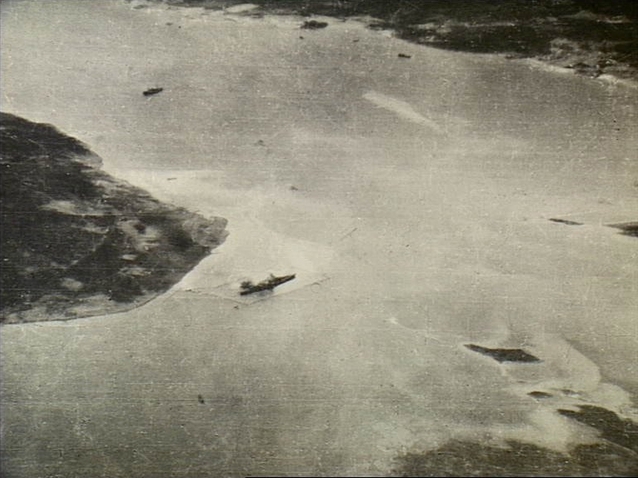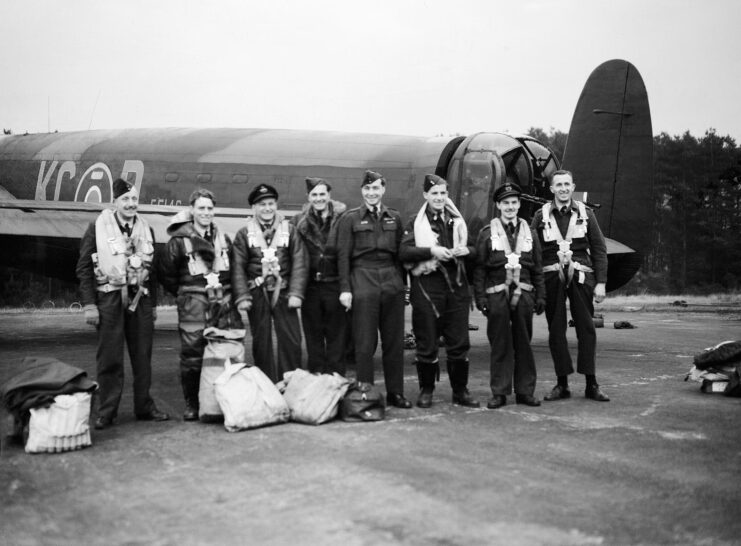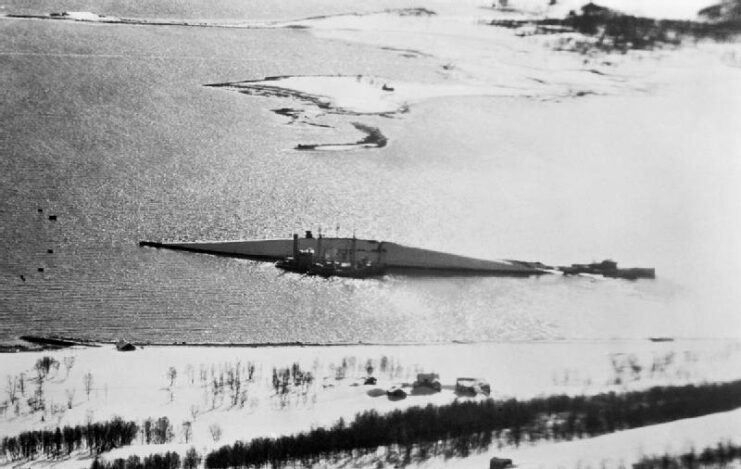When asked about Germany’s best warships during the Second World War, odds are Bismarck and Tirpitz come to mind. These behemoths, with their over 50,000-ton displacements and 15-inch guns, wreaked havoc on the Allies in the waters off northern Europe, with Bismarck, notably, taking out the Royal Navy’s HMS Hood (51) during the Battle of the Denmark Strait.
While Bismarck was lost in May 1941, her sister ship continued to aid the Kriegsmarine‘s efforts. Aware of how much of a threat Tirpitz posed, the British made it their goal to take out the vessel. After many tries, they did so with Operation Catechism.
Several unsuccessful attacks were launched against Tirpitz

From as early as 1942, the Allies (in particular, the British) were aware of how dangerous it would be to let the Germans continue to operate Tirpitz. The heaviest battleship ever constructed by a European navy, she had the potential to greatly impact efforts in the north, with the greatest fears revolving around convoys transiting the Norwegian Sea to the USSR.
This led the Allies to launch several assaults against Tirpitz. The Royal Air Force (RAF) largely led these efforts, with four air raids taking place between January and April 1942, all of which were unsuccessful. The Royal Navy was also recruited, deploying mini submarines to attach mines to the ship’s hull. While these caused considerable damage, they failed to take her out of commission.
Allied attacks continued into 1944, with aircraft being launched from carriers. These, too, failed to take out Tirpitz, leading to further operations being handled by the RAF Bomber Command.
From active warship to floating artillery battery

With the task of sinking Tirpitz now in the hands of the RAF Bomber Command, the decision was made to launch yet another air raid. Dubbed Operation Paravane, it involved aircraft from two RAF squadrons, No. 617 and 9, and resulted in enough damage to the German battleship that she was deemed unfit for combat.
Grossadmiral Karl Dönitz, commander-in-chief of the Kriegsmarine, ordered Tirpitz be anchored off the coast of Håkøya, near the city of Tromsø, where she’d be used as a floating artillery battery. He mistakenly believed that the site was shallow enough to prevent the ship sinking if another attack occurred – a belief that would come back to haunt him.
Along with using her deck guns for defense, the Germans enlisted torpedo nets, anti-aircraft gun emplacements and ships, and seven fishing boats equipped with smoke generators to protect Tirpitz from an aerial assault.
On October 29, 1944, 39 Avro Lancasters with the No. 617 and 9 Squadrons took off from their bases in northern Scotland for another attack on Tirpitz. Unfortunately, overcast skies made them unable to hit their target, with their Tallboys missing their marks. A single one exploded near the ship, causing hull damage, but, overall, the mission was unsuccessful.
Launching Operation Catechism

On November 12, 1944, an attack similar to the one conducted on October 29 was launched. Dubbed Operation Catechism, it saw 32 modified Lancasters from the No. 617 and 9 Squadrons RAF, as well as a film unit one from No. 463 Squadron RAAF, take off, once again, for the coast of Håkøya.
Between 7:39 and 8:50 AM, German observation posts reported sightings of British Lancasters, but assumed they were heading for the Soviet Union, given one was seen flying to the east. As such, Tirpitz‘s crew wasn’t notified until 8:15 AM, with just a few reports delivered to Jagdgeschwader 5 (JG 5), the fighter wing charged with defending Tromsø.
In fact, it was another hour before the battleship requested aircraft be dispatched – far too late for them to arrive on time.
Tirpitz capsizes

The attack on Tirpitz began at 9:41 AM. This time around, the weather was perfect, and while the Lancasters had to deal with anti-aircraft fire from below, they were met with relatively little resistance.
Two, possibly three, Tallboys hit their mark. While the first, falling between two turrets, failed to detonate, the second hit between the funnel amidships and the aircraft catapult, broke through the hull and exploded, causing significant damage. The third is said to have struck Tirpitz on the port side of another turret, while two others were near misses.
Within minutes, Tirpitz was beginning to capsize. The strike from the second bomb led to an order to abandon ship, with an explosion just 18 minutes later injuring many of the sailors swimming to safety and causing the ship to fully capsize.
The British had finally succeeded; Tirpitz was lost.
Aftermath of Operation Catechism

While the British suffered only a damaged Lancaster during Operation Catechism, the Germans weren’t so lucky. Of the estimated 1,700 crewmen aboard Tirpitz at the time of the raid, between 940 and 1,204 were lost, with most trapped in the battleship’s hull. Miraculously, some were rescued when holes were cut into the hull, but the majority couldn’t be saved.
The Luftwaffe – specifically, Maj. Heinrich Ehler, commander of III./Jagdgeschwader 5 – received most of the blame for Tirpitz’s loss. Ehler was court-martialed and sentenced to three years in prison, but was released after only a month and then reassigned to a Messerschmitt Me 262 fighter squadron. He was killed in combat the following year.
Ehler was later exonerated after it was determined poor communication between the Kriegsmarine and the Luftwaffe was the real reason for the lack of air support. The latter hadn’t been informed that Tirpitz had been moved near Håkøya.
More from us: USS Tang (SS-306): The Decorated US Submarine That Was Sunk By Her Own Torpedo
Are you a fan of all things ships and submarines? If so, subscribe to our Daily Warships newsletter!
As for the Allies, Tirpitz‘s destruction meant Germany had no capital ships to threaten their convoys. This signaled a major shift in the fighting taking place in northern Europe, and it allowed for the redeployment of troops to other areas that were in need of additional support.
